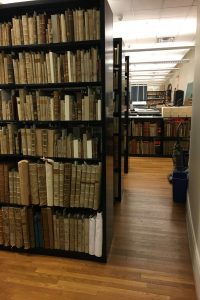
Rare Books was formally added to Special Collections in May 2019, joining the University Archives, Museum, and Manuscripts, also known as the American Catholic History Research Collection. New acquisitions have been a challenge while operating in a climate of budget and staff limits even before the onset of the COVID Crisis. However, we are pleased to report on four recent notable arrivals. Purchasing rare books, including pamphlets, is not a matter to be taken lightly. Several factors have to be accounted for, such as the reputation of the seller, price and provenance of the item, as well as whether the item has already been digitized or is available in print copies from other libraries. While the Rare Books collection at Catholic University is strong in many subject areas, we are looking to expand our Anti-Catholic literature, the Catholic Apologetics defending the Faith, and acquire more Spanish and indigenous language items from both North and South America.
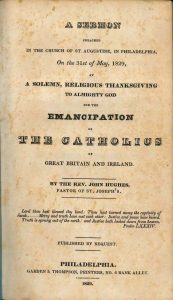
The first of the aforementioned acquisitions is a sermon pamphlet obtained in October 2019 from David Lesser of Fine Antiquarian Books in Woodbridge, Connecticut. Titled ‘A Sermon Preached in the Church of St. Augustine, in Philadelphia, on the 31st of May, 1829, at A Solemn, Religious Thanksgiving to Almighty God for the Emancipation of The Catholics of Great Britain and Ireland.’ By the Rev. John Hughes. Spanning 28 pages, it is in good condition and only lightly foxed. Born in Ireland, John Joseph Hughes became the fourth Bishop and first Archbishop of the Archdiocese of New York, serving from 1842 to 1864. He was known as ‘Dagger John’, both for his following of the Catholic practice wherein a bishop precedes his signature with a cross, as well as for his aggressive personality. At the time of this sermon, he was the pastor of a church located in Philadelphia. He dedicated his sermon to Daniel O’Connel, who was known as ‘The Liberator,’ due to his tireless lobbying for Catholic Emancipation in both Ireland and Great Britain. Philadelphia had been a center of anti-immigrant political unrest. Hughes’s address to this largely Irish-American congregation reminded them of the oppression that was historically directed towards Roman Catholics, and celebrated the British Parliament’s recent granting of fuller civil rights towards Catholics.
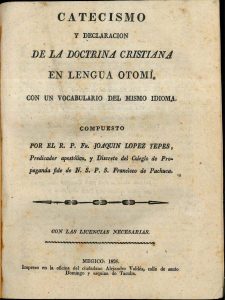
The second new addition was a book purchased in February 2020 from Rulon-Miller Books of Saint Paul, Minnesota. Written by Joaquin Lopez Yepes and published by Alejandro Valdes in 1826 in Mexico, it is a Catechism and Dictionary (Catecismo y declaracion de la Doctrina Cristiana en lengua Otomi, con un vocabulario del mismo idioma. Megico: impreso en la oficina de ciudadano) in both Spanish and the indigenous language of Otomi. This first edition has 254 pages, with a dictionary spanning pages 93-251. It is comprised of red morocco backed marbled boards, and has a smooth gilt spine that is laid out in six compartments. Otomi differs in structure from other languages spoken in Mexico, as it strongly resembles the languages of Eastern Asia. Luis de Neve y Molina was the first to establish a system of characters in 1767, which has been retained. Otomi is a monosyllabic language, which is still spoken today by nearly two million inhabitants of central Mexico. The author was a native Mexican and a religious brother of the Franciscan College at Pachuca. Many consider his vocabulary to be the most complete ever published in this language.
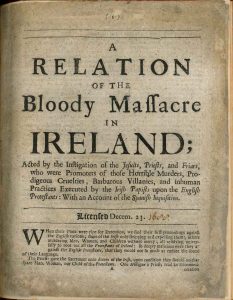
The third recent arrival is a pamphlet from Paul Dowling of Liber Antiquus, Early Books & Manuscripts, located in Chevy Chase, Maryland. It was purchased in May 2020 and is titled A Relation of the Bloody Massacre in Ireland; Acted by the Instigation of the Jesuits, Priests, and Friars, who were Promoters of those Horrible Murders, Prodigeous Cruelties, Barbarous Villanies, and Inhuman Practices Executed by the Irish Papists upon the English Protestants: With an Account of the Spanish Inquistition. London: Rowland Reynolds, 1689. This first edition is bound in recent quarter calf and marbled boards and has a spine label. There are four known copies in the United States, residing in the Folger Shakespeare Library, the Newberry Library, and at Yale and Harvard universities. The first leaf is soiled with marginal repairs and is illustrated with five woodcuts, two show images of mayhem and three depict torture scenes as practiced by the Spanish Inquisition. The first part was apparently issued as a news report in 1641 while the second part on the Inquisition is original. In this sensational account, the Irish are alleged to have tortured Protestants by drowning thousands and compelling family members to kill their own kin: “Wives were forced to hang their own husbands, and mothers to cast their own children into the waters.” This book was published in response to the tumult in Ireland that followed the Glorious Revolution of 1688. Catholic Ireland had to accept the military occupation and endure the rule of the Protestant regime of William of Orange. In 1689 several London printing houses recirculated pamphlets that had originally published in 1641 during the Irish Rebellion. Although readers of the republished Relation of the Bloody Massacre in Ireland were not provided with an introduction, they were able to recognize its relevance towards the present situation.
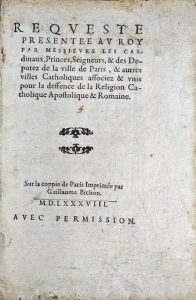
The fourth new acquisition is a Catholic League pamphlet printed in French, dated May 23, 1588, and purchased in July 2020 from Robert Heron of Three Gables in Nottinghamshire, United Kingdom. It’s English title is Presentation to the King by Cardinals, Princes, Lords, and Deputies of the City of Paris and other Catholic cities associated and united for the defense of the Catholic Religion (Requeste Presentee au Roy par Messieurs les Cardinaux, Princes, Seigneurs, & des Deputez de la ville de Paris, & autre villes Catholiques associez & unis pour la deffence de la Religion Catholique Apostolique & Romaine). In 1576, Henry, duc de Guise, formed the Catholic League to eradicate all French Protestants. On May 12, 1588, known as the ‘Day of the Barricades,’ King Henry III was forced to flee Paris to escape a popular uprising called by de Guise. This rare 16-page pamphlet was most likely printed in Lyon from the original which was published in Paris. It was a plea to the King, now in refuge at the royal Chateau de Blois, to embrace the Catholic cause in the Wars of Religion, which developed as the Reformation spread across Europe into France. Although Henry III made a formal reply to this request, he also took direct action by summoning de Guise and his brother, a Cardinal, to de Blois before Christmas of 1588 where he had them both killed. This led to many more League pamphlets and Henry’s assassination on August 1, 1589 by a Dominican friar. This pamphlet is unbound, protected by a brown paper cover, and in good condition even though the first few pages are somewhat dirty from frequent handling over the past 400 years.
In conclusion, these four new acquisitions, published in four countries, in four languages, across four centuries, represent the diversity of our ever growing collection of Rare Books at The Catholic University of America. We are dedicated to providing preservation, maintenance, and above all, access, to these cultural treasures and we invite you to contact us with any questions you might have.

Congratulations on these interesting acquisitions. We have a great collection in many respects.
Thank you for sharing. The acquisition of the Catechism in Spanish and Otomi is a wonderful addition to the Rare Books collection of catechisms.
Great work!